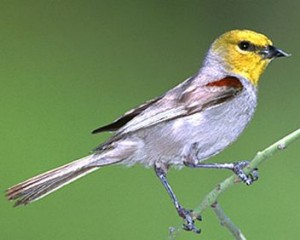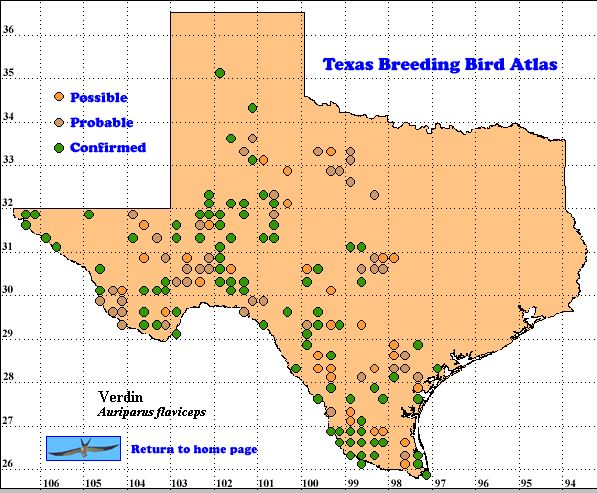The tiny Verdin, a gleaner of small insects and spiders from the foliage of desert vegetation, is most notable for its nest-building behavior. In addition to breeding nests, Verdins also build individual roosting nests whose insulation allows them to survive cold winter nights. Verdins are among the smallest of North American birds, averaging only 6.9 g (about 0.24 oz; at the end of a winter day), smaller than the weight of a male Blue-throated Hummingbird (Lampornis clemenciae) and equal to the weight of female blue-throats (Williamson 2000). Verdins spend the night in their roosting nests, smaller versions of their breeding nest, but the birds still lose an average of 7% of their body mass during a winter night. Roosting nests may be built any time of the year and the interwoven twig structures may remain attached to a bush or tree for years, giving an exaggerated impression of population size (Harrison 1979, Webster 1999).
Verdins are the only New World members of the family Remizidae (Old World penduline tits), a family near Paridae (chickadees and titmice) in taxonomic arrangement. Placement of Verdin in Remizidae is supported by genetic and morphological studies and feeding behavior (Webster 1999).
DISTRIBUTION. During the 1987-1992 field work of the TBBA project, observers found most Verdins breeding in the regions adjoining the Rio Grande River, Trans-Pecos, Edwards Plateau, South Texas Brush Country and Coastal Sand Plain (see the region map in Lockwood and Freeman [2004]). Scattered records were also reported from the Rolling Plains and southern High Plains.
Outside Texas Verdins breed primarily on the Mexican mainland at all but the highest elevation, north of the central volcanic belt and on the Baja California peninsula. In the United States, the highest relative abundances are found in Arizona below the Mogollon Rim and in southeastern California. Verdins also reside in the extreme southern portions of Nevada and New Mexico (Howell and Webb 1995, Webster 1999, Sauer et al. 2005)).
SEASONAL OCCURRENCE. Year-round residents throughout their range, Verdins breed from early March to August, and occasionally September, based on egg dates from March 25 to September 15 (Oberholser 1974). TBBA atlasers found confirmed breeding evidence from February 25 to July 17. Most records came from March to June with one in February and 2 in July. In Arizona almost all breeding records were obtained between early March and early July (Wise-Gervais 2005).
BREEDING HABITAT. Verdins breed in Texas from near sea level to about 1800 m (6000 ft) in thorny scrub on hillsides and along arroyos and gulchs (Oberholser 1974). In Arizona 59% of breeding observations came from desert vegetation dominated by legume family trees, such as mesquite and palo verde, on slopes and flat areas as well as along normally dry washes (Wise-Gervais 2005).
The breeding nest, built by both sexes, is placed near the outside of the bush or tree, at an average height of 1.8 m (6 ft) above ground. It is a spherical or oval mass of interwoven thorny twigs 15-25 cm (6-10 in) in diameter. Inside the outer shell is a matted layer of leaves, other plant material and feathers, bound with spider silk. Inside this is a lining of grasses, plant down and feathers, leaving a cavity 6.5 cm long, 3.5 wide and 5 high (2.6 x 3.4 x 2 in). An opening in the lower side 3 cm (1.2 in) wide with a platform of twigs gives access. to this cavity (Webster 1999). Harrison (1979) has a photo of a nest.
In the cavity the female usually lays 4 (range 3-6) blue-green to pea green or greenish white eggs with irregular reddish, brown or grayish spotting. The eggs are incubated for 14-18 days. The nestlings fledge about 27-32 days after hatching and parents feed them for another 18 days. About half of Verdin pairs attempt a second brood (Webster 1999).
STATUS. Verdins are considered uncommon to common residents of their Texas range (Lockwood and Freeman 2004). On 70 North American Breeding Bird Survey (BBS) routes in Texas this little bird was detected at relative abundances up to 3-10 Verdins per route. In the Sonoran Desert of southern Arizona detections were as high as 10-30 Verdins per route during a similar time period as that of the TBBA project. Data from the Texas BBS routes produced an alarming statistically significant yearly population change of -7.8% for the period 1966-2005. This statewide trend is probably due to changes in the South Texas Brushland during the 1966-1979 period for which BBS data from 14 routes produced a statistically significant -19.4% population change per year. Fortunately conditions in that region apparently changed before 1980, since the 1980-2005 trend from 19 routes in the South Texas Brushland produced an annual population change of +4.8% (significant at the 90% level; Sauer et al. 2005).
Text by Robert C. Tweit (2006)
Literature cited.
Harrison, H. H. 1979. A field guide to western birds’ nests. Houghton Mifflin, Boston, MA.
Howell, S. N. G. and S. Webb. 1995. A guide to the birds of Mexico and northern Central America. Oxford University Press, New York.
Lockwood, M. W. and B. Freeman. 2004. The TOS handbook of Texas birds. Texas A&M University Press, College Station.
Oberholser, H. C. 1974. The bird life of Texas. University of Texas Press, Austin.
Sauer, J. R., J. E. Hines, and J. Fallon. 2005. The North American Breeding Bird Survey, results and analysis 1966-2005. Version 6.2 2006. USGS Patuxent Wildlife Research Center, Laurel MD < http://www.mbr-pwrc.usgs.gov/bbs>
Webster, M. D. 1999. Verdin (Auriparus flaviceps). In The birds of North America, No. 470 (A. Poole and F. Gill, eds.). The Birds of North America, Inc., Philadelphia, PA.
Williamson, S. L. 2000. Blue-throated Hummingbird (Lampornis clemenciae). In The birds of North America, No. 531 (A. Poole and F. Gill, eds.). The Birds of North America, Inc., Philadelphia, PA.
Wise-Gervais, C. 2005. Verdin (Auriparus flaviceps). In Arizona breeding bird atlas. pp. 390-391 (T. E. Corman and C. Wise-Gervais, eds.). University of New Mexico Press, Albuquerque.

